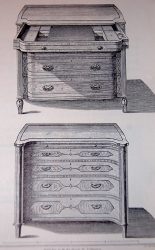The Regency Period
The Regency Period
By Hannah Crouthamel in Furniture Designers
The English Regency period in decorative arts covers more than the nine years from 1811 to 1820 when George, Prince of Wales, (the Prince Regent) took over from his ailing father King George III. Most authorities categorize the Regency period, as it pertains to the decorative arts, as the first 30 years of the 19th century. Those were the years when the Prince of Wales had the greatest influence over the tastes of the time. The first ten years of the century saw the Georgian period in decline and the Regency in the ascendency, the twenty years were dominated by the designs favored by the Prince Regent, later to become George IV.
The Regency period as it relates to fine arts does not start or end on one day; there is both a build up and a denouement. Many things affected furniture design, from the practical to the events of the day.  The Regency period ushered in different ideas in house design for the influential. There was a greater emphasis on more open, informal (comparatively speaking) room arrangement, more thought given to the functionality of a home; how to make it more convenient and comfortable. Windows became larger; the indoors and the garden merged; and furniture became lighter and smaller scale so it could be moved more easily. The notable military engagements of the time proved to have an important influence on design.
The Regency period ushered in different ideas in house design for the influential. There was a greater emphasis on more open, informal (comparatively speaking) room arrangement, more thought given to the functionality of a home; how to make it more convenient and comfortable. Windows became larger; the indoors and the garden merged; and furniture became lighter and smaller scale so it could be moved more easily. The notable military engagements of the time proved to have an important influence on design.
In 1798 Rear Admiral Sir Horatio Nelson led the English against the French in the Battle of the Nile. This fueled greater interest in ancient Egypt. Egyptian motifs – sphinxes, Egyptian heads, hieroglyphics, and crocodiles (as the public imagined Nelson to be surrounded by them on the Nile) were integrated into furniture design. With Nelson’s victories came furniture detailed with marine motifs of knotted ropes, dolphins, shells and anchors. With his death in 1805 at the Battle of Trafalgar, ebony inlay was utilized more heavily, black symbolizing the country’s state of mourning for its greatest hero.
(more…)

